Unless you’ve been living under a rock these last few months, you’ve probably heard of the marriage equality debate. At least, you’ve probably heard of the “gay marriage” debate. Sure, I hear you say, I’ve heard of it – and? Well, pretending for a moment that I don’t care what you think about the issue itself, I’d like to draw your attention to the difference between these two terms, and to what the evolving discourse of the debate means for the LGBT+ community.
First, there was a switch – particularly, but not exclusively, on the side of the advocates – from talking about “gay marriage” to talking about “same sex marriage.” This was done partly to escape the negative connotations of ideas such as the ‘gay agenda’ and ‘gay lifestyle,’ on which the opposition to marriage equality heavily relies. It also serves, however, to recognise that not all same-sex attracted people are gay. But wait, I hear you say; I thought that’s what gay meant! Well, first of all, while some people do use it as a blanket term, some women are uncomfortable with or do not identify with the term ‘gay’. These days, the terminology tends to reflect personal preference, but historically, the use of the term ‘lesbian’ reflects a wider recognition of the intersectional impact of homophobia and sexism that homosexual women face, but that homosexual men do not. On top of this consideration, the shift from “gay” to “same sex” marriage is inclusive of people who are not exclusively same-sex attracted; for example, the oft-ignored ‘B’ of the now well-known LGBT+ acronym.
The B stands for “bisexual”, which, at its most basic level, refers to somebody who is attracted to both men and women. For those of you who can handle venturing beyond the gender binary, ‘bisexuality’ is usually used to refer to either attraction to your own gender and another gender, or to your own gender and other genders. This leads to various accusations from both the hetero- and homosexual communities, including that bisexuals are “greedy”, that they lack commitment, that they should “pick a side”, and that they are driven by a desire for attention, rather than by biological impulse or honest identification.
These perceptions are reinforced by the oversexualisation and trivialisation of bisexuality in popular media, such as with the common, usually minor and usually objectified, female character who “had a lesbian phase during college.” Some shows – for example, Buffy the Vampire Slayer, and even the notoriously progressive Orange is the New Black – feature main characters (Willow and Piper respectively) who have significant on-screen romantic and sexual relationships with both males and females, but who are never identified as bisexual. Representation, or lack thereof, such as this perpetuates the idea that bisexuality is not real, but rather, a phase or a situational switch between hetero- and homosexual attraction.
This is called ‘bisexual erasure’, and it has plagued the marriage equality debate and the wider LGBT+ movement for years. Bisexuals are often excluded from queer advocacy and pride spaces on the grounds that they are faking it, or that they are “straight-passing.” This, in the marriage context, means that they could be in a heterosexual relationship and therefore could get married under Australia’s current law if they wanted to, and that therefore, their complaints are invalid. To biphobic marriage equality activists: whatever happened to “love is love”? To marriage equality opponents: whatever happened to the sanctity of marriage? Do you realise you’re breaking up marriages that already exist?
That’s right: under Australian law, if you enter into a heterosexual marriage, and then one of you wishes to legally change your gender, you must dissolve the marriage. Living as a member of the gender with which you identify is a vital criterion for legally recognised change. Because marriage in Australia is defined as being “between a man and a woman,” this means that the transgender person would either have to transition and make their marriage invalid, or else continue to be recognised as their gender assigned at birth, which can cause psychological issues such as dysphoria. The “between a man and a woman” clause also excludes intersex, agender and other nonbinary people from being able to legally marry, or maintain their existing marriage if they wish to legally change their gender.
Considerations such as this led to the second major shift in discourse, from “same sex marriage” to “marriage equality,” which is where we are today. Marriage equality activists wish for the law to allow marriage “between two consenting adults” of any sexual orientation, and of any gender. This recognises that the quest for marriage equality is not just for the G, but also for the L, the B, and the T, fighting to be able to marry – and stay married.
Words by Jasmine Ruscoe

